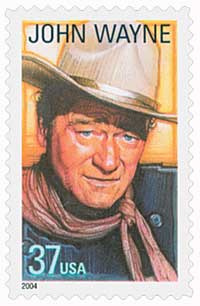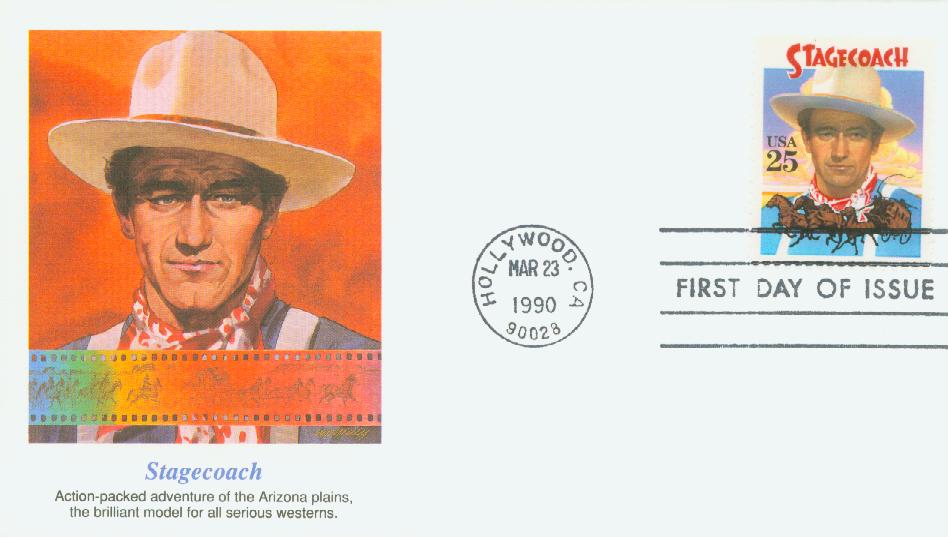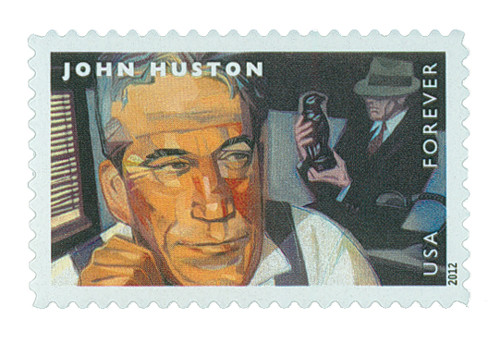
# 4668 - 2012 First-Class Forever Stamp - Great Film Directors: John Ford
U.S. #4668
2012 45¢ John Ford
Great Film Directors
Issue Date: May 23, 2012
City: Silver Spring, MD
Quantity: 6,250,000
Printed By: Avery Dennison
Printing Method: Photogravure
Color: multicolored
Birth Of John Wayne
He was named Marion Morrison after his grandfather. The Morrisons later moved to a homestead in Glendale, California, where Wayne’s father opened a pharmacy in the same building as a movie theater. Wayne was allowed to go to the movies for free several times a week. It was also in California that Wayne’s father taught him to ride horses, handle firearms, and to stand tall as a man.
Wayne received the nickname “Little Duke” from a fireman he saw every morning as he walked with his large Airedale Terrier dog, Duke. The name stayed with him for the rest of his life.
In high school, Wayne was both an honor student and an excellent athlete. He received a football scholarship to the University of Southern California, and while there, worked as a scenery mover for Fox Studios. After suffering a bodysurfing injury and losing his scholarship, Wayne was soon cast in bit parts in movies.
Wayne earned his first spot in a movie replacing a stunt man who refused to go in the water off Catalina Island because it was too rough. The director on the film was John Ford, who later launched Wayne’s career by starring him in the movie Stagecoach. However, Wayne would make more than 80 grade-B films before then.
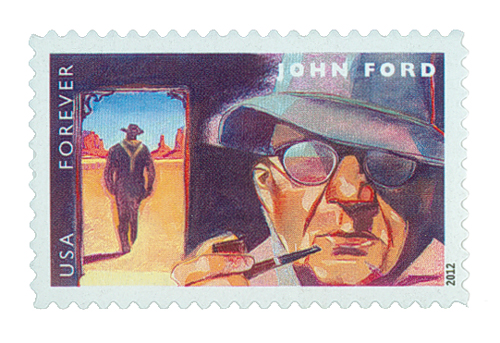
Wayne’s first starring role came in the 1930 film The Big Trail, Hollywood’s first epic Western sound motion picture. It was at this point that he adopted his stage name. The film’s director first suggested Anthony Wayne, after Revolutionary War General “Mad” Anthony Wayne, but Fox executives didn’t like it. They eventually settled on “John Wayne,” though Wayne himself wasn’t even present for the discussion or decision.
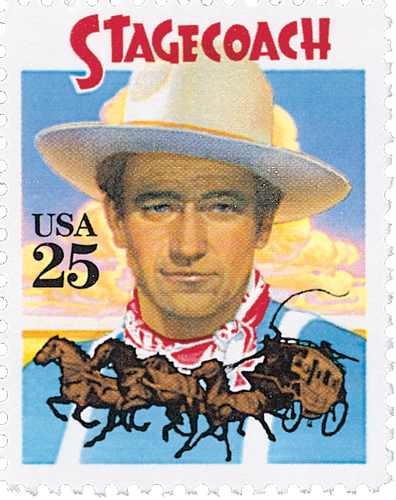
Wayne continued to make predominantly westerns, but it wasn’t until Stagecoach in 1939, that he attained national stardom. This movie was director John Ford’s most-acclaimed film. It was nominated for seven Academy Awards and won two. It introduced America to a rising young star named John Wayne.
Wayne’s first color film was Shepherd of the Hills, in 1941. One of his most popular roles was as a heroic pilot in The High and the Mighty, in 1954. Critics and fans alike praise his portrayal of Ethan Edwards in The Searchers (1956) as one of his best and most complex performances.
Wayne became an American icon and his name and image became synonymous with the rugged Wild West. Wayne’s film performances made him a symbol of the American cowboy, the courageous, patriotic soldier, and the fearless lawman in search of justice. His performance in True Grit in 1969 earned him the Oscar for Best Actor. In 1980, President Jimmy Carter awarded him America’s highest civilian honor, the Presidential Medal of Freedom.
Wayne played the male lead role in 142 of 153 films, setting an industry record. As Hollywood’s most outspoken conservative Republican, Wayne was asked to run for president in 1968. He declined because he didn’t believe an actor could be elected to the nation’s highest office.

John Wayne starred in over 200 movies during a span of 50 years. Sadly, it was the filming of a 1955 movie, The Conqueror that many think killed the “Duke.” The filming took place near a nuclear test site where the radioactive bombs had recently been dropped. Although most knew about the radiation (there’s even a picture of Wayne with a Geiger counter) they obviously didn’t realize the danger they were in.
U.S. #4668
2012 45¢ John Ford
Great Film Directors
Issue Date: May 23, 2012
City: Silver Spring, MD
Quantity: 6,250,000
Printed By: Avery Dennison
Printing Method: Photogravure
Color: multicolored
Birth Of John Wayne
He was named Marion Morrison after his grandfather. The Morrisons later moved to a homestead in Glendale, California, where Wayne’s father opened a pharmacy in the same building as a movie theater. Wayne was allowed to go to the movies for free several times a week. It was also in California that Wayne’s father taught him to ride horses, handle firearms, and to stand tall as a man.
Wayne received the nickname “Little Duke” from a fireman he saw every morning as he walked with his large Airedale Terrier dog, Duke. The name stayed with him for the rest of his life.
In high school, Wayne was both an honor student and an excellent athlete. He received a football scholarship to the University of Southern California, and while there, worked as a scenery mover for Fox Studios. After suffering a bodysurfing injury and losing his scholarship, Wayne was soon cast in bit parts in movies.
Wayne earned his first spot in a movie replacing a stunt man who refused to go in the water off Catalina Island because it was too rough. The director on the film was John Ford, who later launched Wayne’s career by starring him in the movie Stagecoach. However, Wayne would make more than 80 grade-B films before then.

Wayne’s first starring role came in the 1930 film The Big Trail, Hollywood’s first epic Western sound motion picture. It was at this point that he adopted his stage name. The film’s director first suggested Anthony Wayne, after Revolutionary War General “Mad” Anthony Wayne, but Fox executives didn’t like it. They eventually settled on “John Wayne,” though Wayne himself wasn’t even present for the discussion or decision.

Wayne continued to make predominantly westerns, but it wasn’t until Stagecoach in 1939, that he attained national stardom. This movie was director John Ford’s most-acclaimed film. It was nominated for seven Academy Awards and won two. It introduced America to a rising young star named John Wayne.
Wayne’s first color film was Shepherd of the Hills, in 1941. One of his most popular roles was as a heroic pilot in The High and the Mighty, in 1954. Critics and fans alike praise his portrayal of Ethan Edwards in The Searchers (1956) as one of his best and most complex performances.
Wayne became an American icon and his name and image became synonymous with the rugged Wild West. Wayne’s film performances made him a symbol of the American cowboy, the courageous, patriotic soldier, and the fearless lawman in search of justice. His performance in True Grit in 1969 earned him the Oscar for Best Actor. In 1980, President Jimmy Carter awarded him America’s highest civilian honor, the Presidential Medal of Freedom.
Wayne played the male lead role in 142 of 153 films, setting an industry record. As Hollywood’s most outspoken conservative Republican, Wayne was asked to run for president in 1968. He declined because he didn’t believe an actor could be elected to the nation’s highest office.

John Wayne starred in over 200 movies during a span of 50 years. Sadly, it was the filming of a 1955 movie, The Conqueror that many think killed the “Duke.” The filming took place near a nuclear test site where the radioactive bombs had recently been dropped. Although most knew about the radiation (there’s even a picture of Wayne with a Geiger counter) they obviously didn’t realize the danger they were in.






